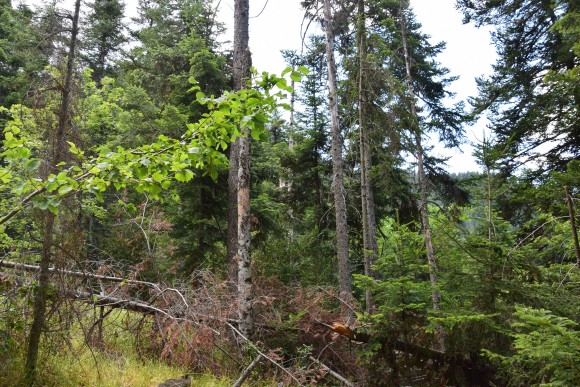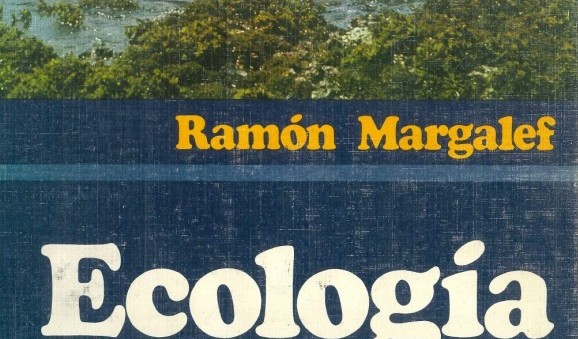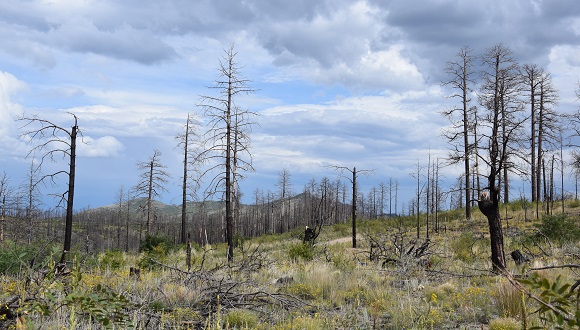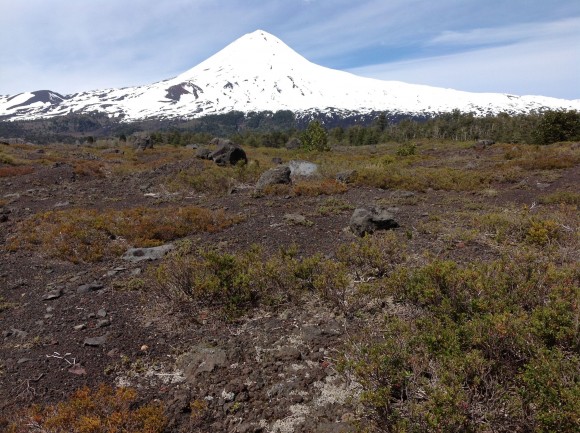Nunc incrementa lente exeunt, festinatur in damnum
For Ramon Margalef, in the centenary of his birth.
Why do not we find ecosystems in the atmosphere, as in oceans and continents? In the atmosphere, spores, pollen grains and micro-organisms float, most of them expelled from soils. But trophic networks are not established, nor are there large flows of energy and matter controlled by living beings.

Some authors have indicated that conditions are given in the atmosphere for resident micro-organisms to be metabolically active and reproduce. In the atmosphere there is light, water, and nutrients, although some of them, like the phosphorus, are scarce not having volatile forms. But the reality is that the existence of functional ecosystems is minimal compared to oceans and continents. It is true that together there are not many resources and they are not homogeneously distributed, but some are there.
Therefore, other reasons should be considered to explain the atmospheric desert. The atmosphere is a mixture of dynamic gases, constantly moving. The waters of the oceans also move, but much more slowly as they are denser. On the other hand, terrestrial ecosystems are based on a much more stable environment, soils. The terrestrial primary producers are anchored to the ground and this anchorage provides them with much more stability, despite the atmospheric fluctuation in which their aerial parts are immersed: they live in an interface between the ground and the air. Even in non-rooted organisms, most of them are in contact with the ground and those who fly are relatively close to the surface - at least if we compare it with the thick kilometers that have the atmosphere -. We could imagine the aerial parts of terrestrial ecosystems as extensions that emerge from the soil towards a richer medium in radiation and CO2, but highly unstable. Occasionally, volcanic eruptions or landslides occur, but their frequency is much lower than constant tides, ocean currents and winds. If we think on the masses of water and on the atmosphere, we see that the rule of the abiotic medium is the change, that is to say the displacement of the physical matrix (air, water): episodes of stability are lapses between fluctuations that drag particles. In the terrestrial environment, we find the opposite situation in which those lapses are much longer. It is a complementary vision to the usual, but it is reasonable. As good terrestrial organisms that we are, we consider that the norm is the situation in which we live in, with extensive periods relatively calm, during which we develop our projects, interrupted by unexpected events that often break our constructions. Seneca in the letter XCI to Lucilius already told us about it: "nunc increases lent exeunt, festinatur in damnum". This perception conditions our understanding of ecological processes.
As explained by Ramon Margalef, this process of increase in structure characterizes the ecological succession and allows the organisms to move forward to the future.
The periods of stability allow the main photosynthetic organisms to accumulate biomass, that is to say, physical structures. Trees are a good example. As explained by Ramon Margalef, this process of increase in structure characterizes the ecological succession and allows the organisms to move forward to the future. In this way, living beings accumulate resources for periods when they are scarce as a result of the environmental fluctuations. In addition, those structures modify the environment and make it less variable. Forests generate micro-environment where temperature and humidity oscillate less than in open areas.

Why this obsession to build up structure?
There is a simple explanation. The functioning of living beings is based on a metabolic balance between the acquisition and the expense of energy. If this balance is very tight, it is easy that a fluctuation of the medium will reverse the balance and the organism will collapse. The alternative is to accumulate reserves, and that explains that the balance tends to be positive. As Margalef said, the photosynthetic engine does not stop working while it has the substrate that feeds its biochemical reactions. The surplus can be invested in structures - based on complex C-rich molecules, some of which acquire other functions such as defense -, which in turn optimize that balance, generating a positive feedback. Thus, the trees capture the radiation more effectively than their neighbors of smaller height, besides dampening many fluctuations occurring in the lower layers of the atmosphere. In turn, these structures give the system more resilience facing the future; thus we have another loop of positive feedback.
This accumulation of structure requires a certain time of stability that does not occur in the atmosphere.
This reasoning brings us to the principles of the ecological succession, a series of changes in the time of the ecosystems, keeping a tendency to incorporate structure in the ecosystem. This accumulation of structure requires a certain time of stability that does not occur in the atmosphere. Simultaneously, when biomass is accumulated, the transfer of energy incorporated into the trophic chain - the primary production - does not increase to the same extent: the ratio between production and biomass of the ecosystem tends to decrease. Obviously, these responses become more complex at the species level - with implications in their physiology and life cycle -, of community - with an increase in the total diversity of species -, and of ecosystem - with a greater control of the flows of matter and energy by the biota -. These trends are well appreciated in terrestrial ecosystems, and they also occur in marine ecosystems, as highlighted by Margalef. In the marine case, the greater frequency of the fluctuations of the environment prevents the generation of durable structures, unless they find a substrate to anchor, such as corals, prairies of Posidonia or kelp forests.

Margalef developed the model of ecological succession by extending it beyond plant communities in which succession had initially been formulated. He integrated biological concepts - ranging from physiology to demography -, thermodynamics - related to the transmission of energy and statistical physics - and from system theory or cybernetics. Many of these disciplines had been consolidated in the first half of the twentieth century. It was the decades after the birth of system theory, that, using statistical physics, had settled through quantum theory and the work of Boltzman. Margalef was very connected with the most innovative currents of the science of his time and applied the physical theories under development, searching for general ecological principles. He understood succession according to these advances, with a holistic perspective in which the transformations of ecological structures through time became essential, through homeostasis and self-organization.
Margalef understood succession according to these advances, with a holistic perspective in which the transformations of ecological structures through time became essential, through homeostasis and self-organization.
The brothers E. Odum and H. T. Odum in their book Fundamentals of Ecology of 1953 had developed a cybernetic vision of ecology and, when considering the succession, they had described the functional and structural modifications associated to succession at the ecosystem level. In that line, Margalef in his book Ecology of the year 1974 characterized the succession by the trend of reduction of the quotient between primary production and biomass, and by the existence of feed-backs that regulate the process. For him, the energy transformed into matter and information constituted the essence of ecological principles and of life itself. Ultimately, the thermodynamic laws regulated the ecosystem processes, as they would later formalize the work of mathematicians, physicists and chemists, who, like I. Prigogine, studied the physics-chemistry of systems outside thermodynamic equilibrium. The arrow of time, so present in the second law of thermodynamics, plays a very important role in Margalef's thinking: a system cannot be understood without knowing its previous state and it never returns to the precise previous stage. Importantly, certain patterns are repeated along succession, but the options are reduced as the ecological system is consolidating, as it gets mature. Going back to the succession model, the energy and matter flows allow the biota and the environment to be organized, until a fluctuation makes the process to start again. At the level of the species biology, we say that competition favors the most efficient ones, those that have invested more in structure and information

Disturbances as part of the history of ecosystems
But, one fundamental contribution of Margalef was to recognize that succession is only part of the story, to which the disturbances must be added. These temporarily destroy the ecosystems and stop the succession, which starts again. Margalef was interested in the size and frequency of these disturbances, identifying that the general pattern was the existence of few disturbances of great magnitude and many of minor importance. For example, in forest wildfires, most of the burned surface is due to a few fires. This pattern has proved to be robust and applicable to many situations, such as biological diversity, with few very abundant species and many rare species. We have a certain tendency to think that disturbances are the exception and that the periods between them represent the normality - as we have seen before, this is probably due to our terrestrial nature, it would be a cognitive bias-. That may be normal in the terrestrial environment, but it is not so much in the oceans or the water courses and much less in the atmosphere. Therefore, we should think about succession as the transformation of ecosystem between successive disturbances.

In fact, two disturbances are never the same. The set of them, with their different characteristics of extension, magnitude and frequency, is what we call disturbance regime. North American foresters do not understand the dynamics of forests without incorporating their fire regime - after all, the final destination of the fuel is to burn-. Sometimes the disturbance is transforming dramatically the environment and it completely destroys the biota - with the probable exception of some microorganisms -. It is the so-called primary succession, as it happens after a volcanic eruption or with the retreat of a glacier. More often, some pre-existing organisms survive and colonize the site again; we would be facing a secondary succession.

The idea of ecological succession has evolved since the nineteenth century
This complex formulation of the ecological succession came from previous ideas already proposed in the nineteenth century by early ecologist, such as the Danish botanist J.E.B. Warming, who recognized common patterns in plants when faced with similar environmental constraints, or the North American H.C. Cowles, who studied the changes in vegetation of the dunes of Lake Michigan. These ideas crystallized in the works of F.E. Clements, who published in 1916 the book Plant succession; An analysis of the development of vegetation, in which he developed in detail the idea of plant succession. Clements proposed the existence of regularity in the successive vegetal communities until they attain stability in correspondence with the regional climate, originating the so-called climax community.
Clements proposed the existence of a regularity in the successive vegetal communities until they attain stability in correspondence with the regional climate, originating the so-called climax community.
The force of these changes is a process in which established plants modifies the environment, making it more favorable for oncoming plants. Thus, when trees grow in an abandoned field, the environment under their canopy becomes shadow, little suitable for the survival of many herbaceous species that dominated the community before the establishment of the trees. The Clements model assumed a certain idealized view of the community. According to his approach, the community was like an entity that develops in time, in a manner analogous to the development of organisms - plants and animals -. This vision was very soon challenged by other authors, such as H.A. Gleason, who preferred to analyze the individualized behavior of each species, as well as the interactions between them. Other authors, such as British A. Tansley - the first president of the British Ecological Society - pointed out that there were other abiotic factors, such as the type of soil, that determined the species constituting a community. Therefore, different communities could appear in a single climatic region. Despite these problems, the idea that there are regularities through the temporal community changes was, and is still extremely attractive.

What has now been the succession model?
The holistic approach developed by Margalef and Odum was somewhat relegated. At least for terrestrial ecosystems, many ecologists were more interested in the functioning and demographics of discrete organisms, as well as in their interactions, following an evolutionary interpretation, in line with Gleason's vision. Measuring the thermodynamic functioning of organisms and ecosystems was more uncertain than counting individuals or measuring levels of nutrients and carbon. Not without impiety, the very idea of a climax community in balance with climate was abandoned, although it remained at some extent in some disciplines such as geobotany. The changing nature of the environment and the idealism underlying the idea of climax did not facilitate a research program that could scientifically contrast it.
Currently, the succession model is still used regularly to describe foreseeable changes in ecosystems, and more particularly in plant communities, such as those that occur after a disturbance. It is the case of the gaps opened after the fall of trees in forests, which are occupied first by herbs shrubs and finally by trees. However, the debate on the existence or not of a convergence in the species composition of communities developing under similar conditions has remained. Are communities enchained to their fate, determined by climate? Or is there room for chance determining the order of arrival of species, thus generating endless possible communities? In this way, Ecology reproduces the old, classical questions formulated by humans about the existence of a predetermined destination. Recently, a monographic volume dealing with the successional model in vegetation was published in Journal of Ecology. The existence of regularities in the characteristics of the species that are replaced through succession seems a well-established paradigm, although there is enough room for the species composition to vary substantially in different succession cases. In addition, the study of the primary succession becomes increasingly important. It is no longer a matter of exceptional events such as volcanic eruptions - although the succession subsequent to the Mt Saint Hellen blast in western North America has been the most studied in history-. Humans are generating new scenarios of absolute destruction of ecosystems, such as in open-cast mining. The restoration of these habitats requires knowing the natural mechanisms that promote these successions. In addition, the succession is no longer exclusively contemplated as a plant process, from which subsidiary changes occur in animal communities. We begin to understand it as an integral process, in which microorganisms - fungi and protista - and vegetables, form a whole in which, in addition, animals play a fundamental role by pollinating, dispersing or foraging. On the other hand, physics and chemistry are increasingly present in the ecology studying global change, while the integration of ecology into social phenomena will likely give way to more holistic thoughts about our understanding of a world in constant transformation.
This article is an activity in the framework of the celebration of the centenary of the birth of Ramon Margalef.








